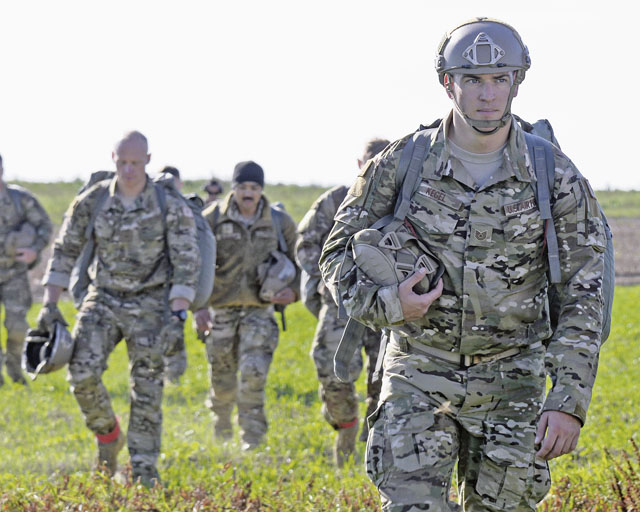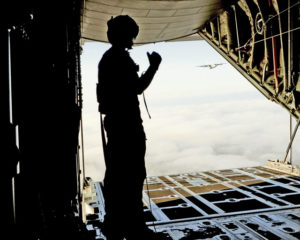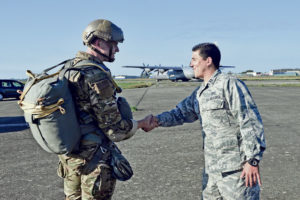
Airmen from the 424th Air Base Squadron at Chièvres Air Base, Belgium, welcomed some visitors who ‘dropped in’ from Ramstein Air Base, in a way not seen in over a half century, Oct. 4.

“It’s the first time in 51 years that we are conducting airdrop exercises at Supreme Headquarters Allied Powers Europe Airfield,” said U.S. Air Force Maj. Tim O’Rourke, 424th ABS Director of Operations. “In addition to the airdrop, crews will be using the newly certified assault landing zone to conduct engine running on-loads and offloads.”
Parajumpers from Ramstein’s 435th Air Ground Operations Wing participated in the jump, conducted from C-130J Super Hercules aircraft assigned to the 37th Airlift Squadron.
As a geographically separated unit of Ramstein’s 86th Airlift Wing, the mission of the 424th ABS is to provide airfield operations support for the Supreme Allied Commander Europe and the NATO. The newly implemented drop zone provides NATO nations a training arena to practice and hone skills vital for combat readiness.
“The objective of the exercise was to demonstrate the new capability of the airfield,” said O’Rourke. “In doing so, we were able to contribute to the readiness and training for tactical airlift crews and airborne units. All of our Airmen were essential to today’s mission. Without their contributions, and the support from the local community, SHAPE, U.S. Army Garrison Benelux, the 86th Operations Group, and the 435th Contingency Response Group, none of this would have been possible.”
Leaders at the 424th ABS have been identifying ways to expand their airfield’s ability to support various Army and Air Force missions and training opportunities.
When it became known that SHAPE airfield had infrastructure to support landing and drop zone operations, research was conducted to determine whether or not it was viable to establish such operations at Chièvres.

A series of site surveys and risk assessments showed the capability was possible, and the landing and drop zones were soon certified for use.
The recent airdrop of 435th AGOW Airmen served as a proof of concept that Chièvres can accommodate tactical airlift training, O’Rourke added.
“If we were to use the proverbial ‘crawl, walk, run,’ I would say we are in the walking stage,” O’Rourke said. “We are getting closer and closer to becoming fully operational in terms of our in-house capabilities to support expanded operations.”
Lt. Col. Craig Lindstrom, 424th ABS commander, described the expansion of Chièvres’ capabilities as a collaborative effort that required ingenuity on the part of all of the squadron’s mission partners. At Chièvres, the U.S. Army operates the installation, while local farmers own portions of the property within the perimeter of the base, including on the airfield.
Lindstrom said the location of SHAPE airfield is ideal for the use of C-130s from Ramstein because of the relatively short flight time and the available maneuvering airspace to conduct airdrops. The squadron’s intent is to look at the airfield not merely as a transit hub but a training arena for NATO aircrews and airborne forces to get realistic, easy-to-schedule training opportunities in the heart of Western Europe.
“We are excited to see this vision become a reality and are hopeful it will make positive contributions to NATO training and readiness,” Lindstrom said.







